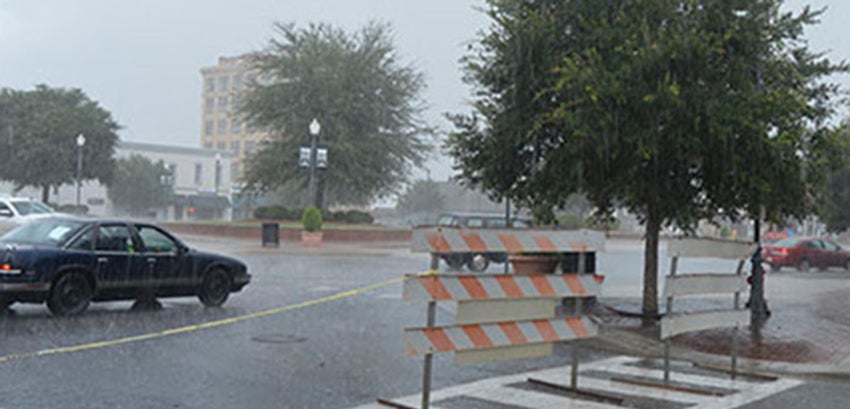EMA: Severe weather possible
Published 1:49 am Tuesday, November 29, 2016

- Aside from a sprinkle earlier this month, it has not rained in the Andalusia area since mid-September.
After two months without rain, two rounds of active weather are coming.
Susan Harris, Covington County EMA director, said that the local area is expected to receive weather into this morning and again late tonight through mid-afternoon tomorrow.
“Two rounds of showers and thunderstorms are still expected to impact our area – on late Monday night into Tuesday morning, with a second round expected to come in late Tuesday night through mid-afternoon Wednesday,” she said. “A few storms could become severe with both events across much of our forecast area. The primary severe weather hazard will be damaging straight-line wind gusts over 60 mph, though isolated brief tornadoes will also be possible.”
Harris said that the severe potential looks limited in nature, but forecasters and EMA officials will be carefully monitoring data to determine if portions of the area may need to be included in an elevated risk.
Storms are expected to make their way here after midnight.
“Additional scattered showers along with isolated thunderstorms could develop again Tuesday afternoon and evening, but the storms are not expected to be severe,” Harris said. “More numerous to widespread showers and thunderstorms are expected to once again move across southeast Mississippi and southwest Alabama late Tuesday night through mid-morning Wednesday, then move eastward across the remainder of the area through mid-afternoon Wednesay ahead of an advancing cold front. Some storms could again be severe during this time frame, with damaging winds and isolated tornadoes.”
Rainfall totals are expected to be between 1.4 inches and 2.3 inches in a line that extends from Gulf Shores to Luverne, with possible isolated higher amounts of 3 to 4 inches affected by stronger, more prolonged thunderstorms.
Widespread rainfall totals east of this line are expected to range from 0.75 inches to 1.4 inches, with possible isolated higher amounts to 2 to 3 inches affected by stronger, more prolonged thunderstorms.
Road ways are expected to be slippery, AAA reports.
“AAA Alabama encourages drivers to use caution on the roads as rain approaches the state for the first time in quite a while,” AAA spokesperson Clay Ingram said. “Oil and grease build-up on the highways mixed with rain always create very slick road conditions, but due to the extended period of time since the last rain, this problem will be much worse than usual.”
Ingram said the oil and water mixture causes the pavement to be extremely slippery until the oily coating is washed away.
“However, due to the lack of rain in recent weeks, this oil and grease build-up will be quite a bit heavier than usual and will take much longer to wash away,” he said. “Drivers should be aware that roads and highways will be considerably more dangerous than usual over the next few days.”
AAA offered the following tips for drivers to stay safe:
- Allow more travel time. Plan to drive at a slower pace than normal when the roads are wet. Rushing equals a higher risk for collision.
- Buckle up. Also confirm the position of mirrors before you start the vehicle.
- Keep you windshield and windows clean. It’s important to clean the inside of your windows. If the glass gets foggy, open a window slightly and turn the defroster fan to a higher speed. Use you air conditioner to reduce humidity.
- Keep headlights clean. When motorists drive on wet streets, mud and dirt can splash onto you headlights, reducing illumination by up to 90 percent. Stop periodically during a long trip to clean your headlights.
- Drive with your daytime running lights or low-beam headlights on at all times.
, especially on dark, or overcast days. Also use low-beam headlights in fog.
- Recognize crisis. When visibility is so limited drivers cannot see the edges of the road or other vehicles at a safe distance, the driver should consider pulling off the road and waiting for the rain to ease up. It’s best to stop at a rest area or exit the freeway and go to a protected area. If the roadside is your only option, pull off the road as far as you can, preferably past the end of a guardrail.
- Wet roads mean poor traction. Conditions are most dangerous during the first 10 minutes of a heavy downpour, as oil and other debris rise up and then wash away. Knowing how to handle poor traction reduces the potential for hydroplaning, skidding or getting stuck in the mud.
- Avoid using cruise control in wet weather driving conditions. This feature works great in dry weather scenarios, but when used in wet conditions the chance of losing control of your vehicle increases.
- Sudden braking often leads to skids. Stopping on a slippery surface requires more distance, so increase your following distance. Focus your attention as far ahead as possible – at least 20 to 30 seconds. Give a truck or bus extra distance.




